Advanced project management: Construction of a two-storey house
VerifiedAdded on 2023/05/28
|14
|3064
|203
AI Summary
Critical analysis of a project for construction of a two-storey house, challenges faced by the construction industry, feasible team and construction method for the project.
Contribute Materials
Your contribution can guide someone’s learning journey. Share your
documents today.

Running head: ADVANCED PROJECT MANAGEMENT
Advanced project management: Construction of a two-storey house
Student Name:
University Name:
Advanced project management: Construction of a two-storey house
Student Name:
University Name:
Secure Best Marks with AI Grader
Need help grading? Try our AI Grader for instant feedback on your assignments.

1ADVANCED PROJECT MANAGEMENT
Executive Summary
In this report, critical analysis has been presented on a project for construction of two-storey
house. This report focuses on the major challenges that are likely to affect construction phase of
the project. It has been identified that there are various challenges associated with the
construction project that may be faced in context to the parent organization, AEC industry and
project management discipline. For execution of the construction project, a schedule has been
prepared that is represented as Gantt chart displays that the project will require 190 days. A
feasible team for the project has also been proposed for successful completion of the project.
Further, it has been determined that the construction project could be completed successfully by
executing the project in different phases.
Executive Summary
In this report, critical analysis has been presented on a project for construction of two-storey
house. This report focuses on the major challenges that are likely to affect construction phase of
the project. It has been identified that there are various challenges associated with the
construction project that may be faced in context to the parent organization, AEC industry and
project management discipline. For execution of the construction project, a schedule has been
prepared that is represented as Gantt chart displays that the project will require 190 days. A
feasible team for the project has also been proposed for successful completion of the project.
Further, it has been determined that the construction project could be completed successfully by
executing the project in different phases.
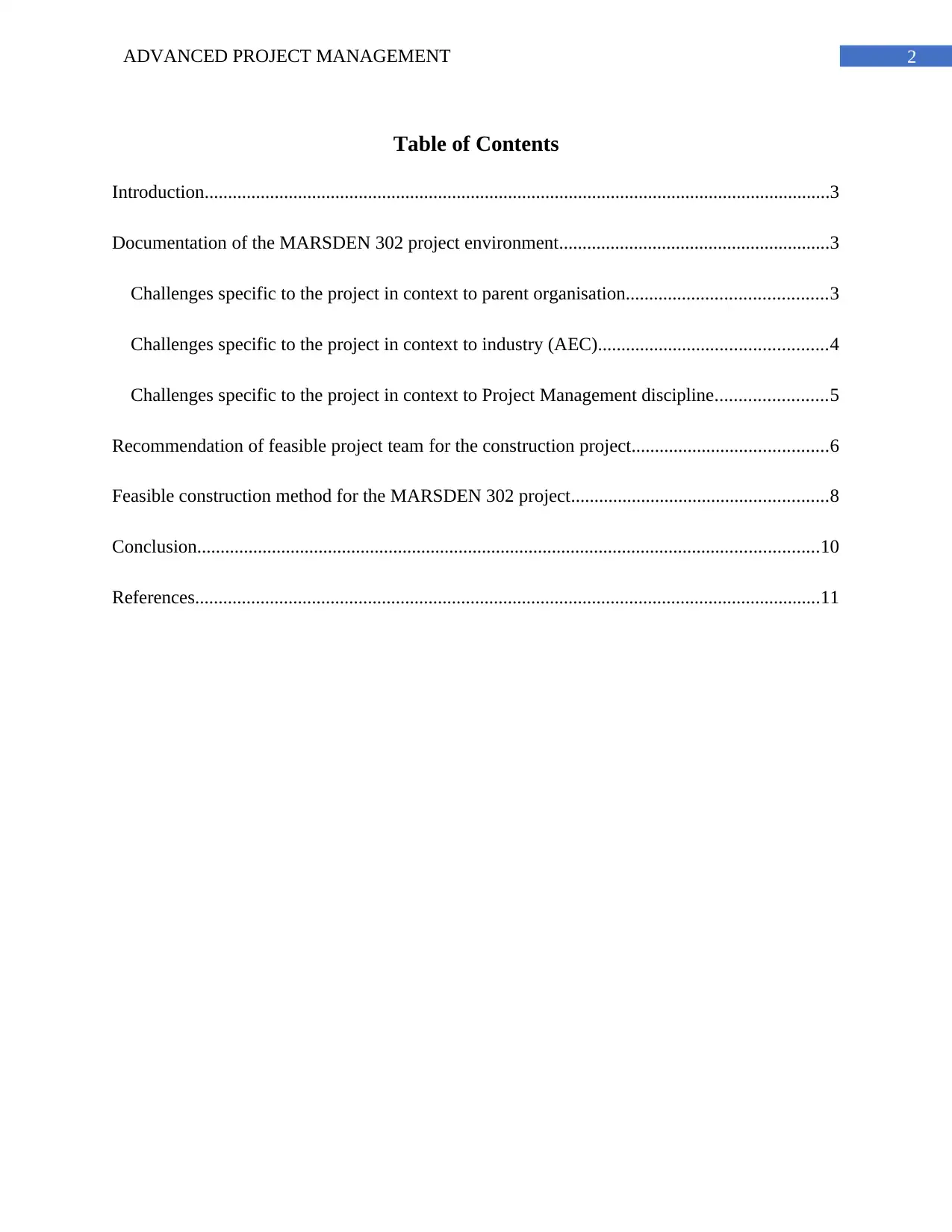
2ADVANCED PROJECT MANAGEMENT
Table of Contents
Introduction......................................................................................................................................3
Documentation of the MARSDEN 302 project environment..........................................................3
Challenges specific to the project in context to parent organisation...........................................3
Challenges specific to the project in context to industry (AEC).................................................4
Challenges specific to the project in context to Project Management discipline........................5
Recommendation of feasible project team for the construction project..........................................6
Feasible construction method for the MARSDEN 302 project.......................................................8
Conclusion.....................................................................................................................................10
References......................................................................................................................................11
Table of Contents
Introduction......................................................................................................................................3
Documentation of the MARSDEN 302 project environment..........................................................3
Challenges specific to the project in context to parent organisation...........................................3
Challenges specific to the project in context to industry (AEC).................................................4
Challenges specific to the project in context to Project Management discipline........................5
Recommendation of feasible project team for the construction project..........................................6
Feasible construction method for the MARSDEN 302 project.......................................................8
Conclusion.....................................................................................................................................10
References......................................................................................................................................11
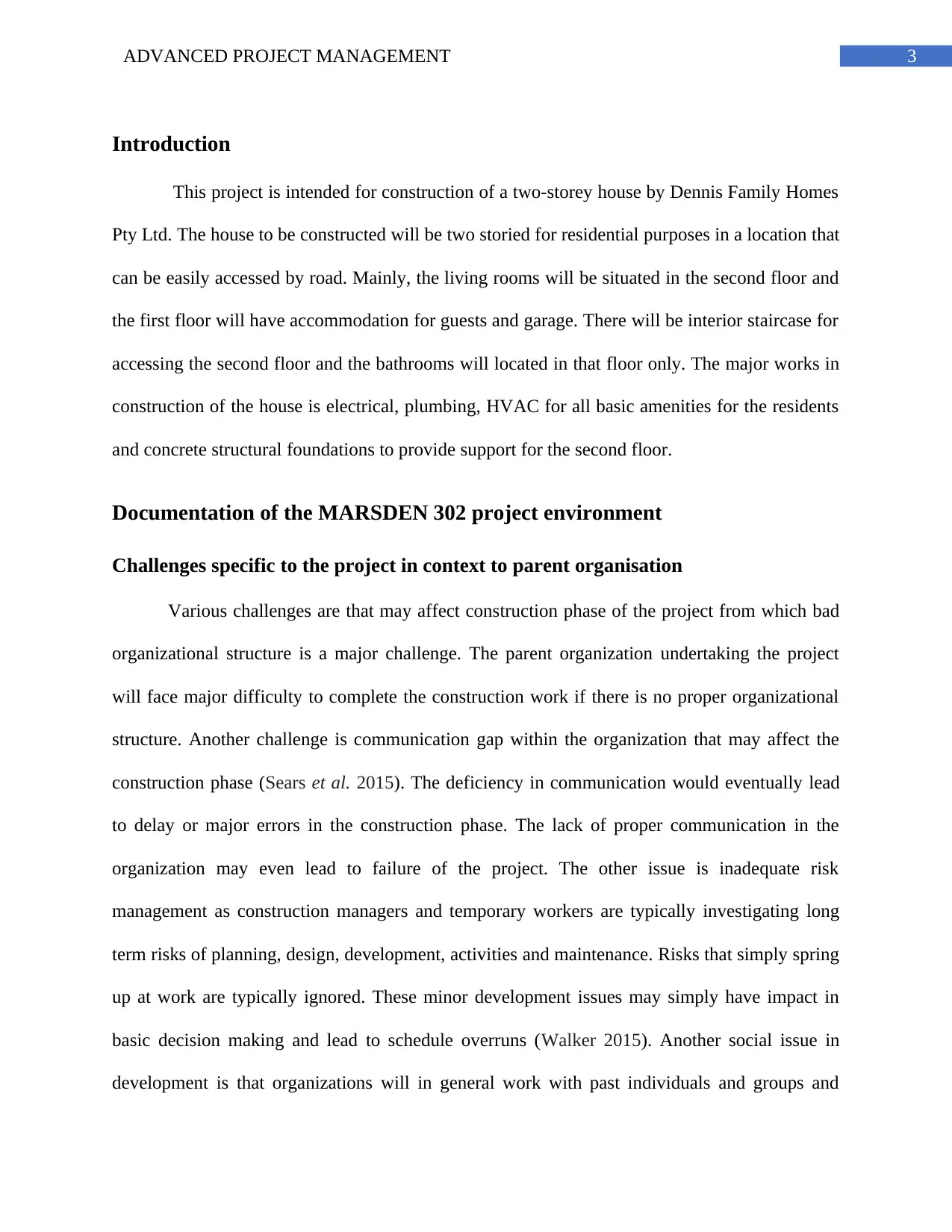
3ADVANCED PROJECT MANAGEMENT
Introduction
This project is intended for construction of a two-storey house by Dennis Family Homes
Pty Ltd. The house to be constructed will be two storied for residential purposes in a location that
can be easily accessed by road. Mainly, the living rooms will be situated in the second floor and
the first floor will have accommodation for guests and garage. There will be interior staircase for
accessing the second floor and the bathrooms will located in that floor only. The major works in
construction of the house is electrical, plumbing, HVAC for all basic amenities for the residents
and concrete structural foundations to provide support for the second floor.
Documentation of the MARSDEN 302 project environment
Challenges specific to the project in context to parent organisation
Various challenges are that may affect construction phase of the project from which bad
organizational structure is a major challenge. The parent organization undertaking the project
will face major difficulty to complete the construction work if there is no proper organizational
structure. Another challenge is communication gap within the organization that may affect the
construction phase (Sears et al. 2015). The deficiency in communication would eventually lead
to delay or major errors in the construction phase. The lack of proper communication in the
organization may even lead to failure of the project. The other issue is inadequate risk
management as construction managers and temporary workers are typically investigating long
term risks of planning, design, development, activities and maintenance. Risks that simply spring
up at work are typically ignored. These minor development issues may simply have impact in
basic decision making and lead to schedule overruns (Walker 2015). Another social issue in
development is that organizations will in general work with past individuals and groups and
Introduction
This project is intended for construction of a two-storey house by Dennis Family Homes
Pty Ltd. The house to be constructed will be two storied for residential purposes in a location that
can be easily accessed by road. Mainly, the living rooms will be situated in the second floor and
the first floor will have accommodation for guests and garage. There will be interior staircase for
accessing the second floor and the bathrooms will located in that floor only. The major works in
construction of the house is electrical, plumbing, HVAC for all basic amenities for the residents
and concrete structural foundations to provide support for the second floor.
Documentation of the MARSDEN 302 project environment
Challenges specific to the project in context to parent organisation
Various challenges are that may affect construction phase of the project from which bad
organizational structure is a major challenge. The parent organization undertaking the project
will face major difficulty to complete the construction work if there is no proper organizational
structure. Another challenge is communication gap within the organization that may affect the
construction phase (Sears et al. 2015). The deficiency in communication would eventually lead
to delay or major errors in the construction phase. The lack of proper communication in the
organization may even lead to failure of the project. The other issue is inadequate risk
management as construction managers and temporary workers are typically investigating long
term risks of planning, design, development, activities and maintenance. Risks that simply spring
up at work are typically ignored. These minor development issues may simply have impact in
basic decision making and lead to schedule overruns (Walker 2015). Another social issue in
development is that organizations will in general work with past individuals and groups and
Secure Best Marks with AI Grader
Need help grading? Try our AI Grader for instant feedback on your assignments.
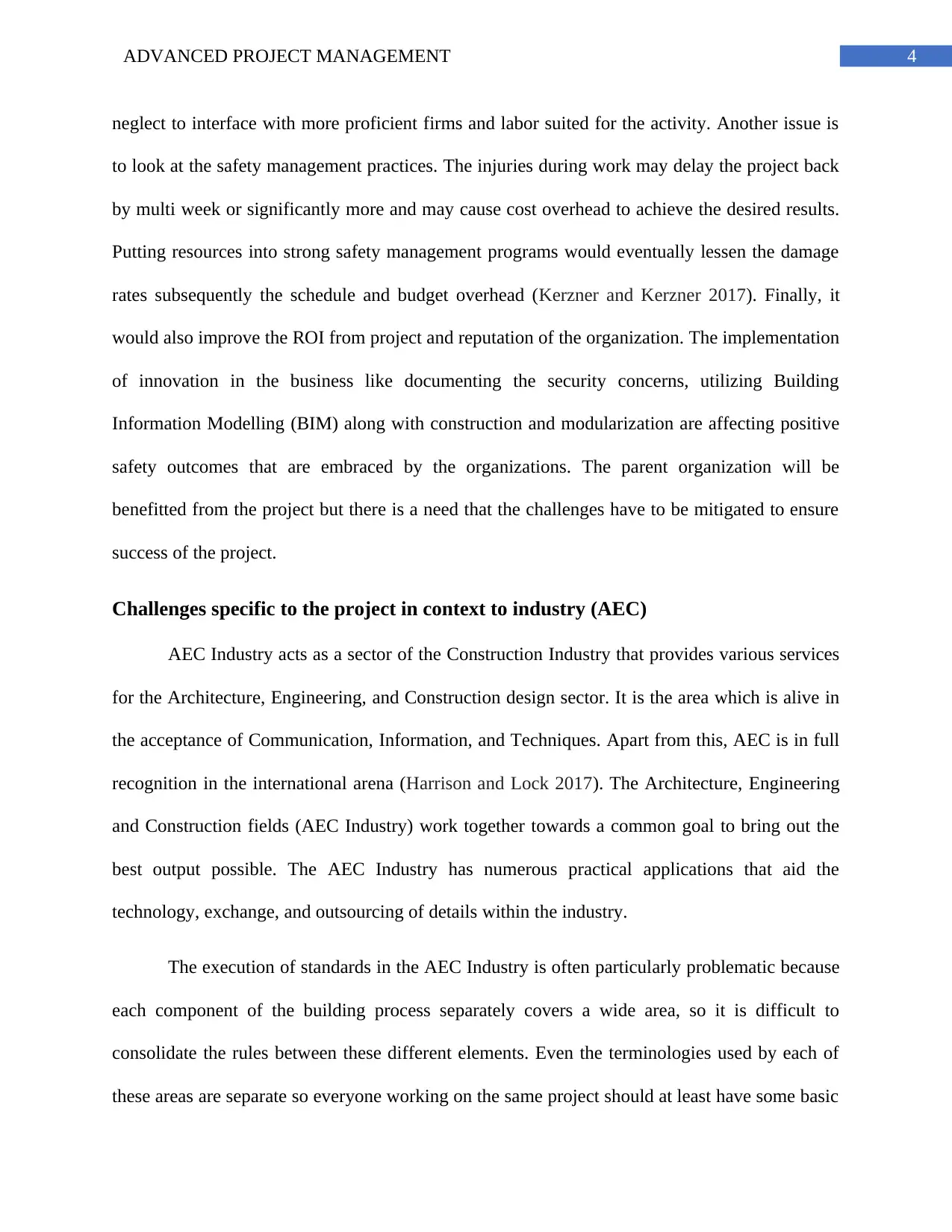
4ADVANCED PROJECT MANAGEMENT
neglect to interface with more proficient firms and labor suited for the activity. Another issue is
to look at the safety management practices. The injuries during work may delay the project back
by multi week or significantly more and may cause cost overhead to achieve the desired results.
Putting resources into strong safety management programs would eventually lessen the damage
rates subsequently the schedule and budget overhead (Kerzner and Kerzner 2017). Finally, it
would also improve the ROI from project and reputation of the organization. The implementation
of innovation in the business like documenting the security concerns, utilizing Building
Information Modelling (BIM) along with construction and modularization are affecting positive
safety outcomes that are embraced by the organizations. The parent organization will be
benefitted from the project but there is a need that the challenges have to be mitigated to ensure
success of the project.
Challenges specific to the project in context to industry (AEC)
AEC Industry acts as a sector of the Construction Industry that provides various services
for the Architecture, Engineering, and Construction design sector. It is the area which is alive in
the acceptance of Communication, Information, and Techniques. Apart from this, AEC is in full
recognition in the international arena (Harrison and Lock 2017). The Architecture, Engineering
and Construction fields (AEC Industry) work together towards a common goal to bring out the
best output possible. The AEC Industry has numerous practical applications that aid the
technology, exchange, and outsourcing of details within the industry.
The execution of standards in the AEC Industry is often particularly problematic because
each component of the building process separately covers a wide area, so it is difficult to
consolidate the rules between these different elements. Even the terminologies used by each of
these areas are separate so everyone working on the same project should at least have some basic
neglect to interface with more proficient firms and labor suited for the activity. Another issue is
to look at the safety management practices. The injuries during work may delay the project back
by multi week or significantly more and may cause cost overhead to achieve the desired results.
Putting resources into strong safety management programs would eventually lessen the damage
rates subsequently the schedule and budget overhead (Kerzner and Kerzner 2017). Finally, it
would also improve the ROI from project and reputation of the organization. The implementation
of innovation in the business like documenting the security concerns, utilizing Building
Information Modelling (BIM) along with construction and modularization are affecting positive
safety outcomes that are embraced by the organizations. The parent organization will be
benefitted from the project but there is a need that the challenges have to be mitigated to ensure
success of the project.
Challenges specific to the project in context to industry (AEC)
AEC Industry acts as a sector of the Construction Industry that provides various services
for the Architecture, Engineering, and Construction design sector. It is the area which is alive in
the acceptance of Communication, Information, and Techniques. Apart from this, AEC is in full
recognition in the international arena (Harrison and Lock 2017). The Architecture, Engineering
and Construction fields (AEC Industry) work together towards a common goal to bring out the
best output possible. The AEC Industry has numerous practical applications that aid the
technology, exchange, and outsourcing of details within the industry.
The execution of standards in the AEC Industry is often particularly problematic because
each component of the building process separately covers a wide area, so it is difficult to
consolidate the rules between these different elements. Even the terminologies used by each of
these areas are separate so everyone working on the same project should at least have some basic

5ADVANCED PROJECT MANAGEMENT
knowledge of the underlying languages (Banihashemi et al. 2017). AEC Industry widely uses
Computer-aided design (CAD) or drafting as a technology. CAD is a type of computer-assisted
building modulation software that engineers, architects, and contractors use to make and test
two- and three-dimensional models. The AEC Industry also uses BIM (Building Information
Modeling) which is a latest programmed modeling software in the construction industry that can
develop four-dimensional models (Nicholas and Steyn 2017). This system can significantly grow
productivity in the AEC Industry, but it usually requires customized and specialized training
because of the complexity level of the process. The AEC industry faces major difficulties while
carrying out construction projects but those have to be resolved with proper measures so that the
projects could be completed successfully. The major challenges being faced by the AEC industry
is lack of ownership determination for the data for construction projects. Another issue that is
being faced during construction is who will take the responsibility of taking control for data
entry. Sometimes, a conflict is raised while determining the person that will undertake the
responsibility of data entry during construction projects. The challenges that has been identified
in context to the AEC industry are wide however, there is scope to mitigate those to ensure
success of construction projects.
Challenges specific to the project in context to Project Management discipline
Many problems faced by construction managers during construction are entirely
avoidable, had sufficient and effective project planning been better before and during
construction. Any construction task is composed of three elements, which are people, materials
and work. The planning of project requires that all the three elements are in place where they are
needed. In some situations, there are cases that one element has to wait for other two or the other
two elements have to wait for the other one. The problems faced by a Project Manager during
knowledge of the underlying languages (Banihashemi et al. 2017). AEC Industry widely uses
Computer-aided design (CAD) or drafting as a technology. CAD is a type of computer-assisted
building modulation software that engineers, architects, and contractors use to make and test
two- and three-dimensional models. The AEC Industry also uses BIM (Building Information
Modeling) which is a latest programmed modeling software in the construction industry that can
develop four-dimensional models (Nicholas and Steyn 2017). This system can significantly grow
productivity in the AEC Industry, but it usually requires customized and specialized training
because of the complexity level of the process. The AEC industry faces major difficulties while
carrying out construction projects but those have to be resolved with proper measures so that the
projects could be completed successfully. The major challenges being faced by the AEC industry
is lack of ownership determination for the data for construction projects. Another issue that is
being faced during construction is who will take the responsibility of taking control for data
entry. Sometimes, a conflict is raised while determining the person that will undertake the
responsibility of data entry during construction projects. The challenges that has been identified
in context to the AEC industry are wide however, there is scope to mitigate those to ensure
success of construction projects.
Challenges specific to the project in context to Project Management discipline
Many problems faced by construction managers during construction are entirely
avoidable, had sufficient and effective project planning been better before and during
construction. Any construction task is composed of three elements, which are people, materials
and work. The planning of project requires that all the three elements are in place where they are
needed. In some situations, there are cases that one element has to wait for other two or the other
two elements have to wait for the other one. The problems faced by a Project Manager during
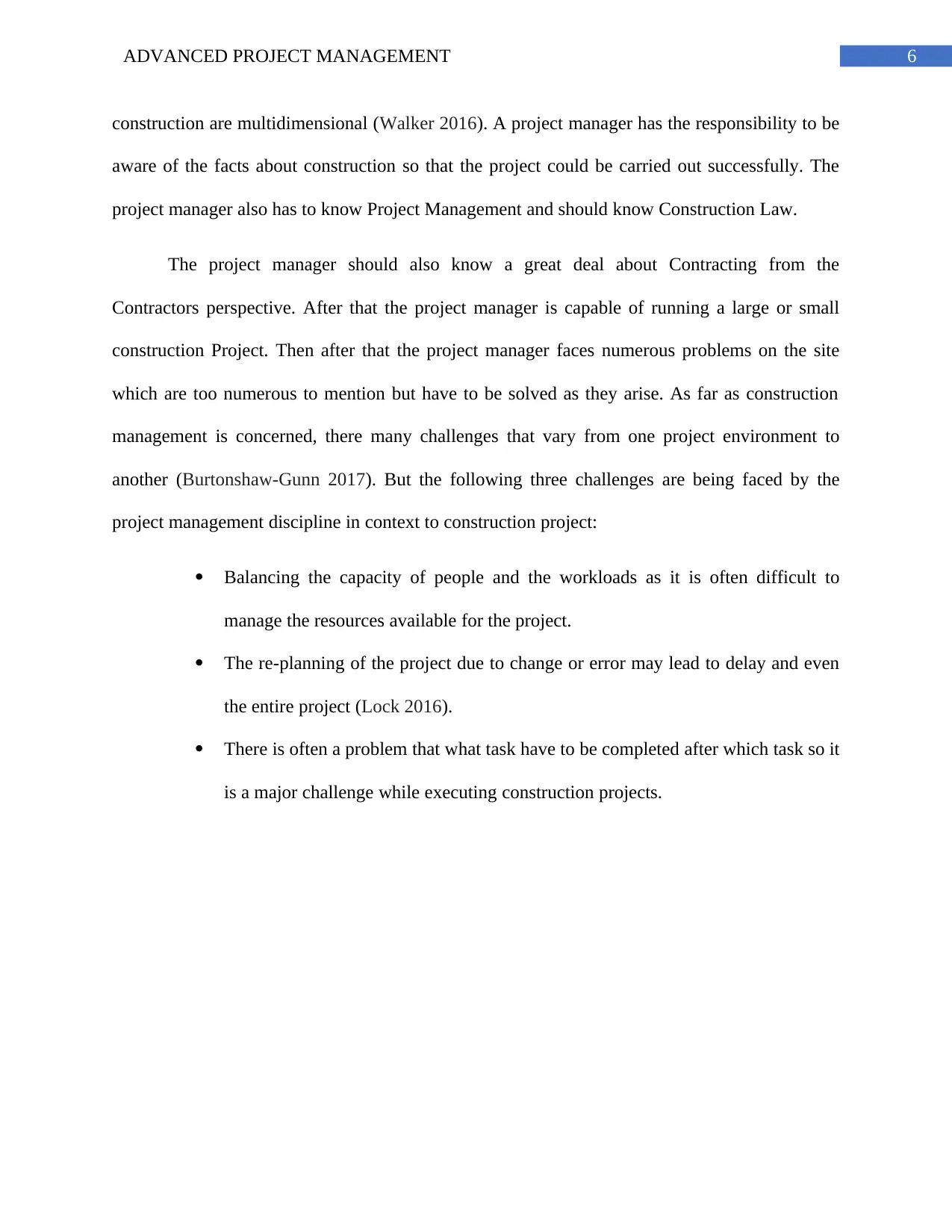
6ADVANCED PROJECT MANAGEMENT
construction are multidimensional (Walker 2016). A project manager has the responsibility to be
aware of the facts about construction so that the project could be carried out successfully. The
project manager also has to know Project Management and should know Construction Law.
The project manager should also know a great deal about Contracting from the
Contractors perspective. After that the project manager is capable of running a large or small
construction Project. Then after that the project manager faces numerous problems on the site
which are too numerous to mention but have to be solved as they arise. As far as construction
management is concerned, there many challenges that vary from one project environment to
another (Burtonshaw-Gunn 2017). But the following three challenges are being faced by the
project management discipline in context to construction project:
Balancing the capacity of people and the workloads as it is often difficult to
manage the resources available for the project.
The re-planning of the project due to change or error may lead to delay and even
the entire project (Lock 2016).
There is often a problem that what task have to be completed after which task so it
is a major challenge while executing construction projects.
construction are multidimensional (Walker 2016). A project manager has the responsibility to be
aware of the facts about construction so that the project could be carried out successfully. The
project manager also has to know Project Management and should know Construction Law.
The project manager should also know a great deal about Contracting from the
Contractors perspective. After that the project manager is capable of running a large or small
construction Project. Then after that the project manager faces numerous problems on the site
which are too numerous to mention but have to be solved as they arise. As far as construction
management is concerned, there many challenges that vary from one project environment to
another (Burtonshaw-Gunn 2017). But the following three challenges are being faced by the
project management discipline in context to construction project:
Balancing the capacity of people and the workloads as it is often difficult to
manage the resources available for the project.
The re-planning of the project due to change or error may lead to delay and even
the entire project (Lock 2016).
There is often a problem that what task have to be completed after which task so it
is a major challenge while executing construction projects.
Paraphrase This Document
Need a fresh take? Get an instant paraphrase of this document with our AI Paraphraser
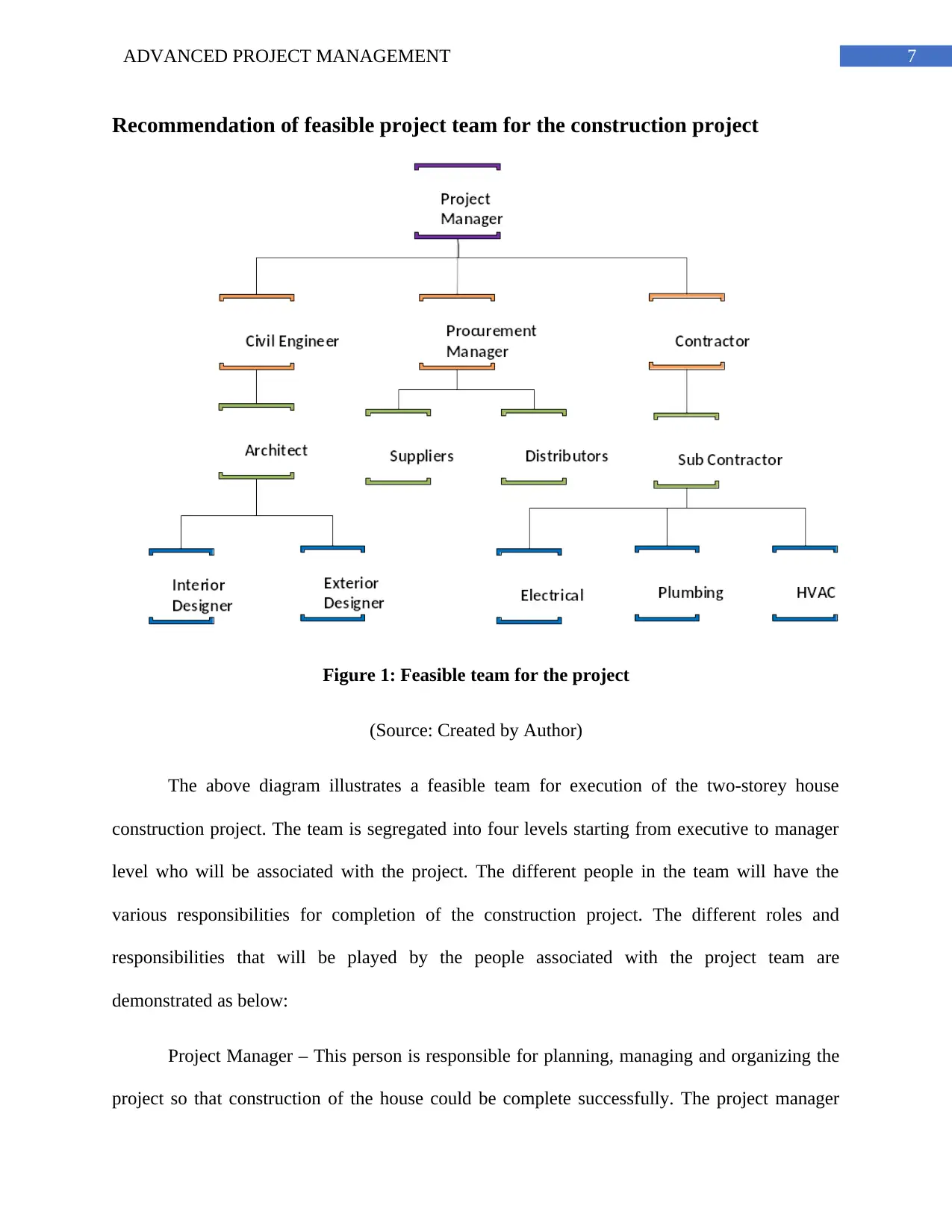
7ADVANCED PROJECT MANAGEMENT
Recommendation of feasible project team for the construction project
Figure 1: Feasible team for the project
(Source: Created by Author)
The above diagram illustrates a feasible team for execution of the two-storey house
construction project. The team is segregated into four levels starting from executive to manager
level who will be associated with the project. The different people in the team will have the
various responsibilities for completion of the construction project. The different roles and
responsibilities that will be played by the people associated with the project team are
demonstrated as below:
Project Manager – This person is responsible for planning, managing and organizing the
project so that construction of the house could be complete successfully. The project manager
Recommendation of feasible project team for the construction project
Figure 1: Feasible team for the project
(Source: Created by Author)
The above diagram illustrates a feasible team for execution of the two-storey house
construction project. The team is segregated into four levels starting from executive to manager
level who will be associated with the project. The different people in the team will have the
various responsibilities for completion of the construction project. The different roles and
responsibilities that will be played by the people associated with the project team are
demonstrated as below:
Project Manager – This person is responsible for planning, managing and organizing the
project so that construction of the house could be complete successfully. The project manager
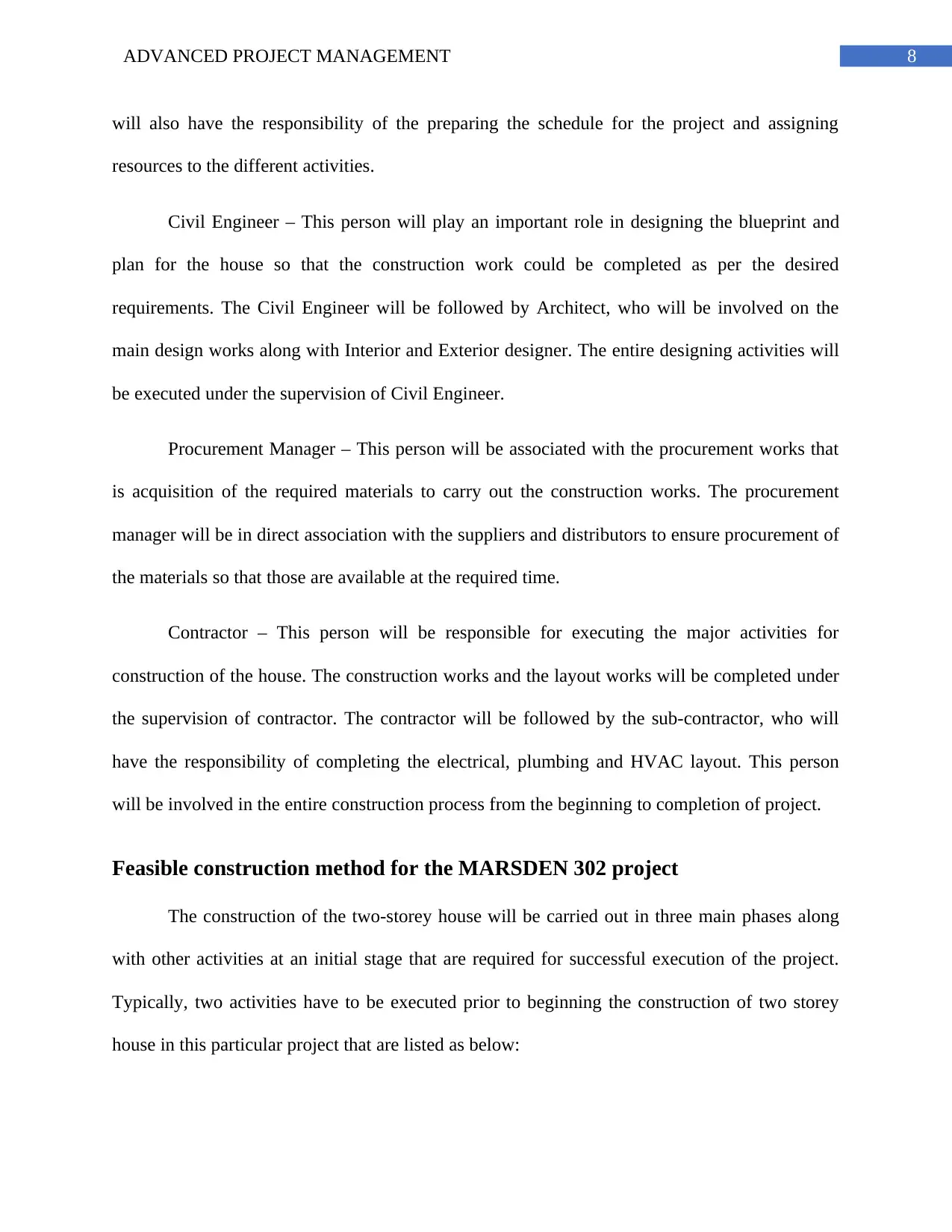
8ADVANCED PROJECT MANAGEMENT
will also have the responsibility of the preparing the schedule for the project and assigning
resources to the different activities.
Civil Engineer – This person will play an important role in designing the blueprint and
plan for the house so that the construction work could be completed as per the desired
requirements. The Civil Engineer will be followed by Architect, who will be involved on the
main design works along with Interior and Exterior designer. The entire designing activities will
be executed under the supervision of Civil Engineer.
Procurement Manager – This person will be associated with the procurement works that
is acquisition of the required materials to carry out the construction works. The procurement
manager will be in direct association with the suppliers and distributors to ensure procurement of
the materials so that those are available at the required time.
Contractor – This person will be responsible for executing the major activities for
construction of the house. The construction works and the layout works will be completed under
the supervision of contractor. The contractor will be followed by the sub-contractor, who will
have the responsibility of completing the electrical, plumbing and HVAC layout. This person
will be involved in the entire construction process from the beginning to completion of project.
Feasible construction method for the MARSDEN 302 project
The construction of the two-storey house will be carried out in three main phases along
with other activities at an initial stage that are required for successful execution of the project.
Typically, two activities have to be executed prior to beginning the construction of two storey
house in this particular project that are listed as below:
will also have the responsibility of the preparing the schedule for the project and assigning
resources to the different activities.
Civil Engineer – This person will play an important role in designing the blueprint and
plan for the house so that the construction work could be completed as per the desired
requirements. The Civil Engineer will be followed by Architect, who will be involved on the
main design works along with Interior and Exterior designer. The entire designing activities will
be executed under the supervision of Civil Engineer.
Procurement Manager – This person will be associated with the procurement works that
is acquisition of the required materials to carry out the construction works. The procurement
manager will be in direct association with the suppliers and distributors to ensure procurement of
the materials so that those are available at the required time.
Contractor – This person will be responsible for executing the major activities for
construction of the house. The construction works and the layout works will be completed under
the supervision of contractor. The contractor will be followed by the sub-contractor, who will
have the responsibility of completing the electrical, plumbing and HVAC layout. This person
will be involved in the entire construction process from the beginning to completion of project.
Feasible construction method for the MARSDEN 302 project
The construction of the two-storey house will be carried out in three main phases along
with other activities at an initial stage that are required for successful execution of the project.
Typically, two activities have to be executed prior to beginning the construction of two storey
house in this particular project that are listed as below:

9ADVANCED PROJECT MANAGEMENT
General preparation – This activity includes acquisition of the construction site and the
preparation of contract agreement with owner of the land. Next, the planning is being done about
resource and budget required for the project (Lock 2017). Finally, after the planning feasibility
study will be carried out to determine success of the project.
Approval requirements – This activity mainly includes acquisition of permits for different
works that is foundations, framing, plumbing, electrical and HVAC installation. In this activity,
the approval for works are being acquired from the local council to ensure compliance with
government building regulations and policies.
For execution of the construction project, a schedule has been prepared that is represented
as Gantt chart below which shows that the project will require 190 days.
1 2 3 4 5 6 7 8 9 10 11 12 13 14 15 16 17 18 19 20 21 22 23 24 25 26 27 28 29 30 31 32 33 34 35 36 37 38
General preparation
Selecting the construction site
Preparation of the contract agreement
Allocation of resource and budget
Feasibility Analysis
Approval requirements
Acquisition of foundation and framing permits
Acquisition of electrical and plumbing permits
Acquisition of HVAC and other permits
Designing phase
Preparation of blueprint for the house
Structural layout and foundation works
Preparation of blueprint for miscellaneous layouts
Construction phase
Concrete works
Masonry working
Beam support works
Roofing works
Plastering and pointing
Doors and windows
Finalizing the interiors
Close-out
Post implementation review
Signoff from stakeholders
Contract signoff
Weeks
Figure 2: Gantt chart for the two-storey house construction project
General preparation – This activity includes acquisition of the construction site and the
preparation of contract agreement with owner of the land. Next, the planning is being done about
resource and budget required for the project (Lock 2017). Finally, after the planning feasibility
study will be carried out to determine success of the project.
Approval requirements – This activity mainly includes acquisition of permits for different
works that is foundations, framing, plumbing, electrical and HVAC installation. In this activity,
the approval for works are being acquired from the local council to ensure compliance with
government building regulations and policies.
For execution of the construction project, a schedule has been prepared that is represented
as Gantt chart below which shows that the project will require 190 days.
1 2 3 4 5 6 7 8 9 10 11 12 13 14 15 16 17 18 19 20 21 22 23 24 25 26 27 28 29 30 31 32 33 34 35 36 37 38
General preparation
Selecting the construction site
Preparation of the contract agreement
Allocation of resource and budget
Feasibility Analysis
Approval requirements
Acquisition of foundation and framing permits
Acquisition of electrical and plumbing permits
Acquisition of HVAC and other permits
Designing phase
Preparation of blueprint for the house
Structural layout and foundation works
Preparation of blueprint for miscellaneous layouts
Construction phase
Concrete works
Masonry working
Beam support works
Roofing works
Plastering and pointing
Doors and windows
Finalizing the interiors
Close-out
Post implementation review
Signoff from stakeholders
Contract signoff
Weeks
Figure 2: Gantt chart for the two-storey house construction project
Secure Best Marks with AI Grader
Need help grading? Try our AI Grader for instant feedback on your assignments.
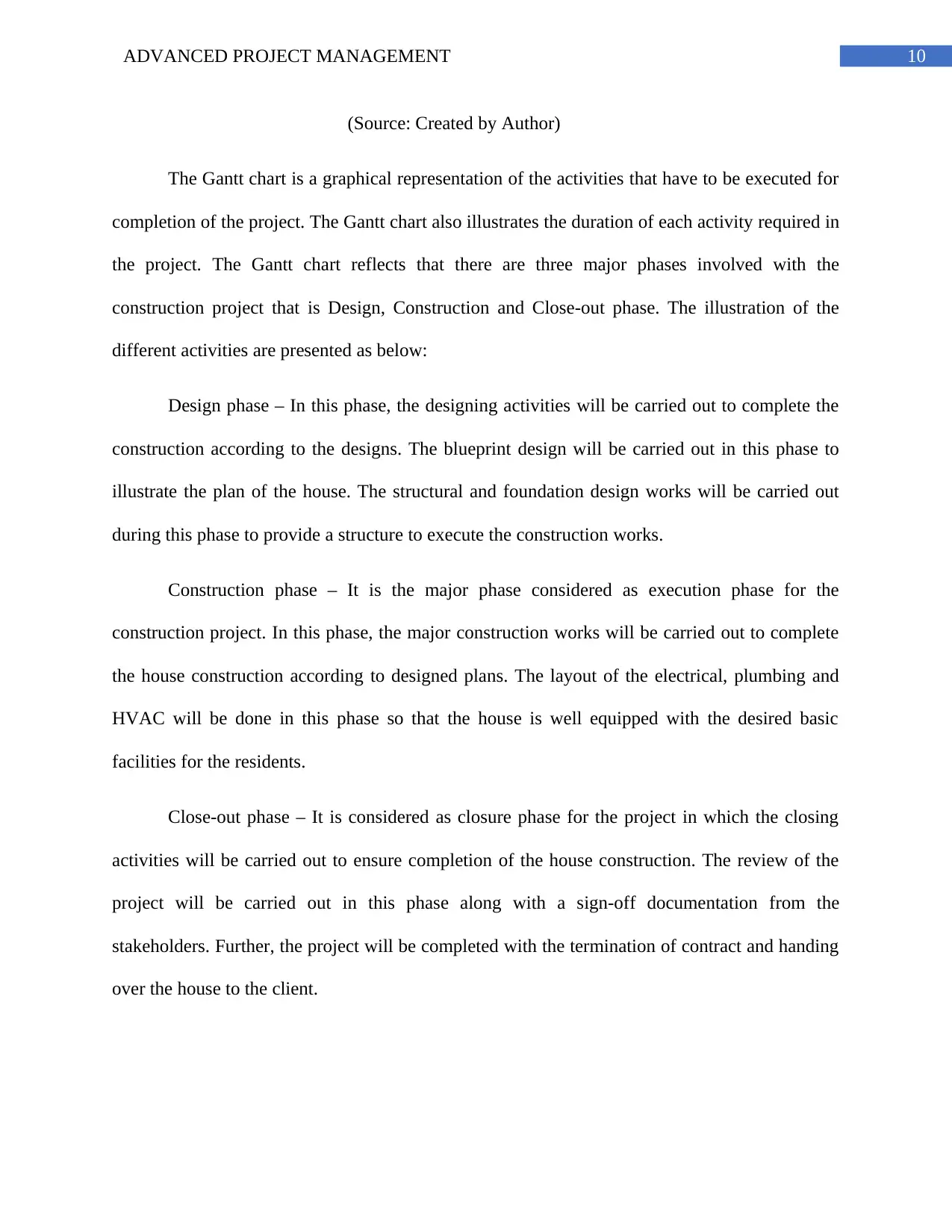
10ADVANCED PROJECT MANAGEMENT
(Source: Created by Author)
The Gantt chart is a graphical representation of the activities that have to be executed for
completion of the project. The Gantt chart also illustrates the duration of each activity required in
the project. The Gantt chart reflects that there are three major phases involved with the
construction project that is Design, Construction and Close-out phase. The illustration of the
different activities are presented as below:
Design phase – In this phase, the designing activities will be carried out to complete the
construction according to the designs. The blueprint design will be carried out in this phase to
illustrate the plan of the house. The structural and foundation design works will be carried out
during this phase to provide a structure to execute the construction works.
Construction phase – It is the major phase considered as execution phase for the
construction project. In this phase, the major construction works will be carried out to complete
the house construction according to designed plans. The layout of the electrical, plumbing and
HVAC will be done in this phase so that the house is well equipped with the desired basic
facilities for the residents.
Close-out phase – It is considered as closure phase for the project in which the closing
activities will be carried out to ensure completion of the house construction. The review of the
project will be carried out in this phase along with a sign-off documentation from the
stakeholders. Further, the project will be completed with the termination of contract and handing
over the house to the client.
(Source: Created by Author)
The Gantt chart is a graphical representation of the activities that have to be executed for
completion of the project. The Gantt chart also illustrates the duration of each activity required in
the project. The Gantt chart reflects that there are three major phases involved with the
construction project that is Design, Construction and Close-out phase. The illustration of the
different activities are presented as below:
Design phase – In this phase, the designing activities will be carried out to complete the
construction according to the designs. The blueprint design will be carried out in this phase to
illustrate the plan of the house. The structural and foundation design works will be carried out
during this phase to provide a structure to execute the construction works.
Construction phase – It is the major phase considered as execution phase for the
construction project. In this phase, the major construction works will be carried out to complete
the house construction according to designed plans. The layout of the electrical, plumbing and
HVAC will be done in this phase so that the house is well equipped with the desired basic
facilities for the residents.
Close-out phase – It is considered as closure phase for the project in which the closing
activities will be carried out to ensure completion of the house construction. The review of the
project will be carried out in this phase along with a sign-off documentation from the
stakeholders. Further, the project will be completed with the termination of contract and handing
over the house to the client.
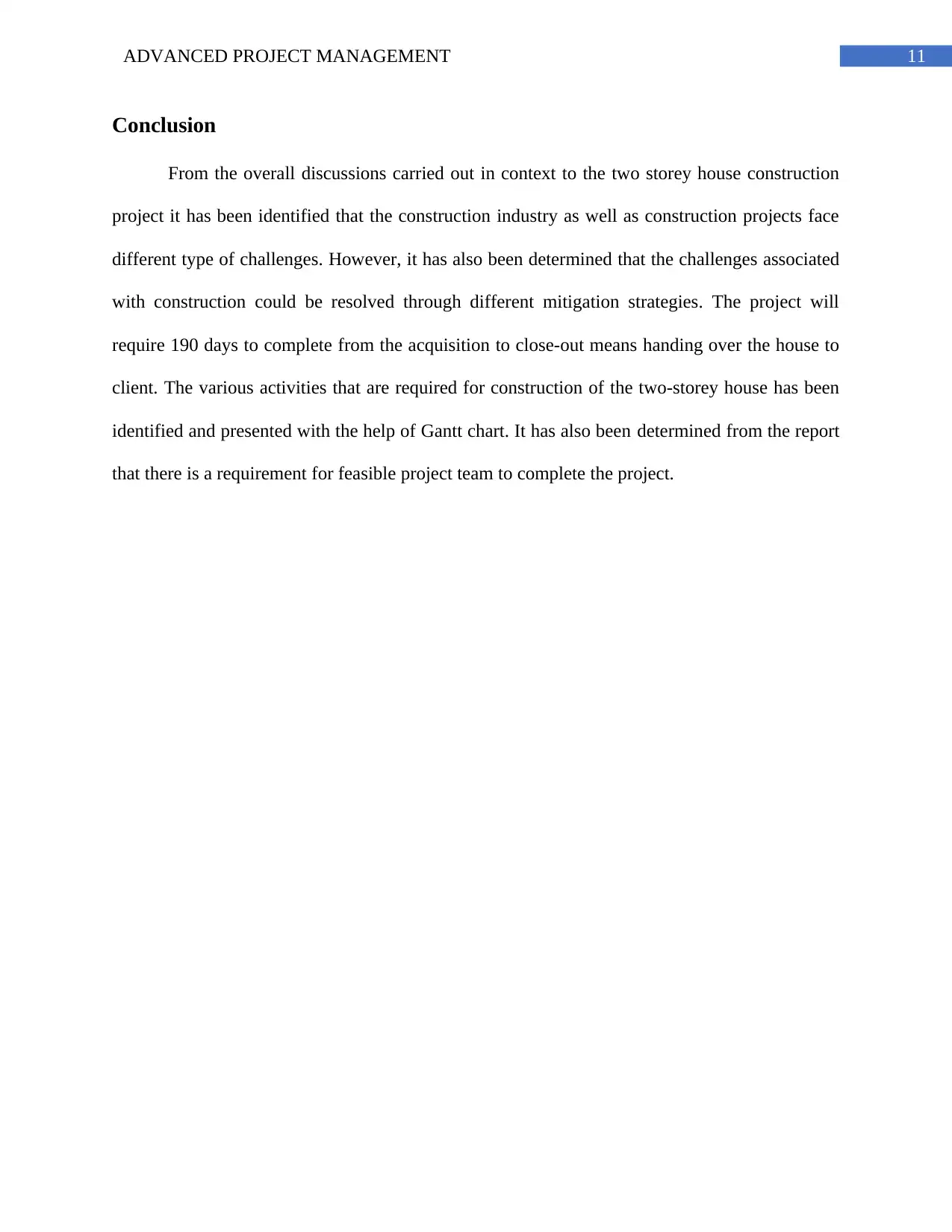
11ADVANCED PROJECT MANAGEMENT
Conclusion
From the overall discussions carried out in context to the two storey house construction
project it has been identified that the construction industry as well as construction projects face
different type of challenges. However, it has also been determined that the challenges associated
with construction could be resolved through different mitigation strategies. The project will
require 190 days to complete from the acquisition to close-out means handing over the house to
client. The various activities that are required for construction of the two-storey house has been
identified and presented with the help of Gantt chart. It has also been determined from the report
that there is a requirement for feasible project team to complete the project.
Conclusion
From the overall discussions carried out in context to the two storey house construction
project it has been identified that the construction industry as well as construction projects face
different type of challenges. However, it has also been determined that the challenges associated
with construction could be resolved through different mitigation strategies. The project will
require 190 days to complete from the acquisition to close-out means handing over the house to
client. The various activities that are required for construction of the two-storey house has been
identified and presented with the help of Gantt chart. It has also been determined from the report
that there is a requirement for feasible project team to complete the project.
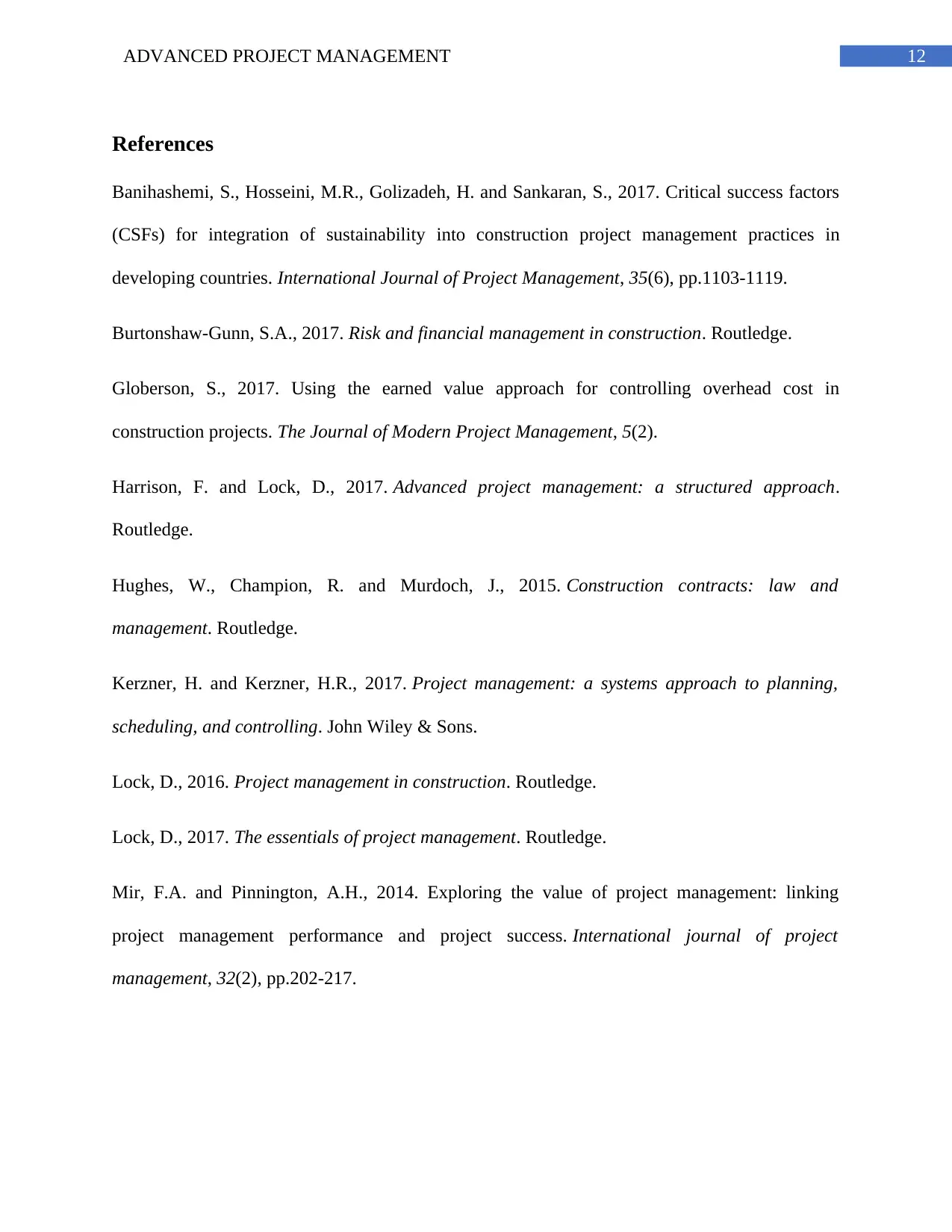
12ADVANCED PROJECT MANAGEMENT
References
Banihashemi, S., Hosseini, M.R., Golizadeh, H. and Sankaran, S., 2017. Critical success factors
(CSFs) for integration of sustainability into construction project management practices in
developing countries. International Journal of Project Management, 35(6), pp.1103-1119.
Burtonshaw-Gunn, S.A., 2017. Risk and financial management in construction. Routledge.
Globerson, S., 2017. Using the earned value approach for controlling overhead cost in
construction projects. The Journal of Modern Project Management, 5(2).
Harrison, F. and Lock, D., 2017. Advanced project management: a structured approach.
Routledge.
Hughes, W., Champion, R. and Murdoch, J., 2015. Construction contracts: law and
management. Routledge.
Kerzner, H. and Kerzner, H.R., 2017. Project management: a systems approach to planning,
scheduling, and controlling. John Wiley & Sons.
Lock, D., 2016. Project management in construction. Routledge.
Lock, D., 2017. The essentials of project management. Routledge.
Mir, F.A. and Pinnington, A.H., 2014. Exploring the value of project management: linking
project management performance and project success. International journal of project
management, 32(2), pp.202-217.
References
Banihashemi, S., Hosseini, M.R., Golizadeh, H. and Sankaran, S., 2017. Critical success factors
(CSFs) for integration of sustainability into construction project management practices in
developing countries. International Journal of Project Management, 35(6), pp.1103-1119.
Burtonshaw-Gunn, S.A., 2017. Risk and financial management in construction. Routledge.
Globerson, S., 2017. Using the earned value approach for controlling overhead cost in
construction projects. The Journal of Modern Project Management, 5(2).
Harrison, F. and Lock, D., 2017. Advanced project management: a structured approach.
Routledge.
Hughes, W., Champion, R. and Murdoch, J., 2015. Construction contracts: law and
management. Routledge.
Kerzner, H. and Kerzner, H.R., 2017. Project management: a systems approach to planning,
scheduling, and controlling. John Wiley & Sons.
Lock, D., 2016. Project management in construction. Routledge.
Lock, D., 2017. The essentials of project management. Routledge.
Mir, F.A. and Pinnington, A.H., 2014. Exploring the value of project management: linking
project management performance and project success. International journal of project
management, 32(2), pp.202-217.
Paraphrase This Document
Need a fresh take? Get an instant paraphrase of this document with our AI Paraphraser
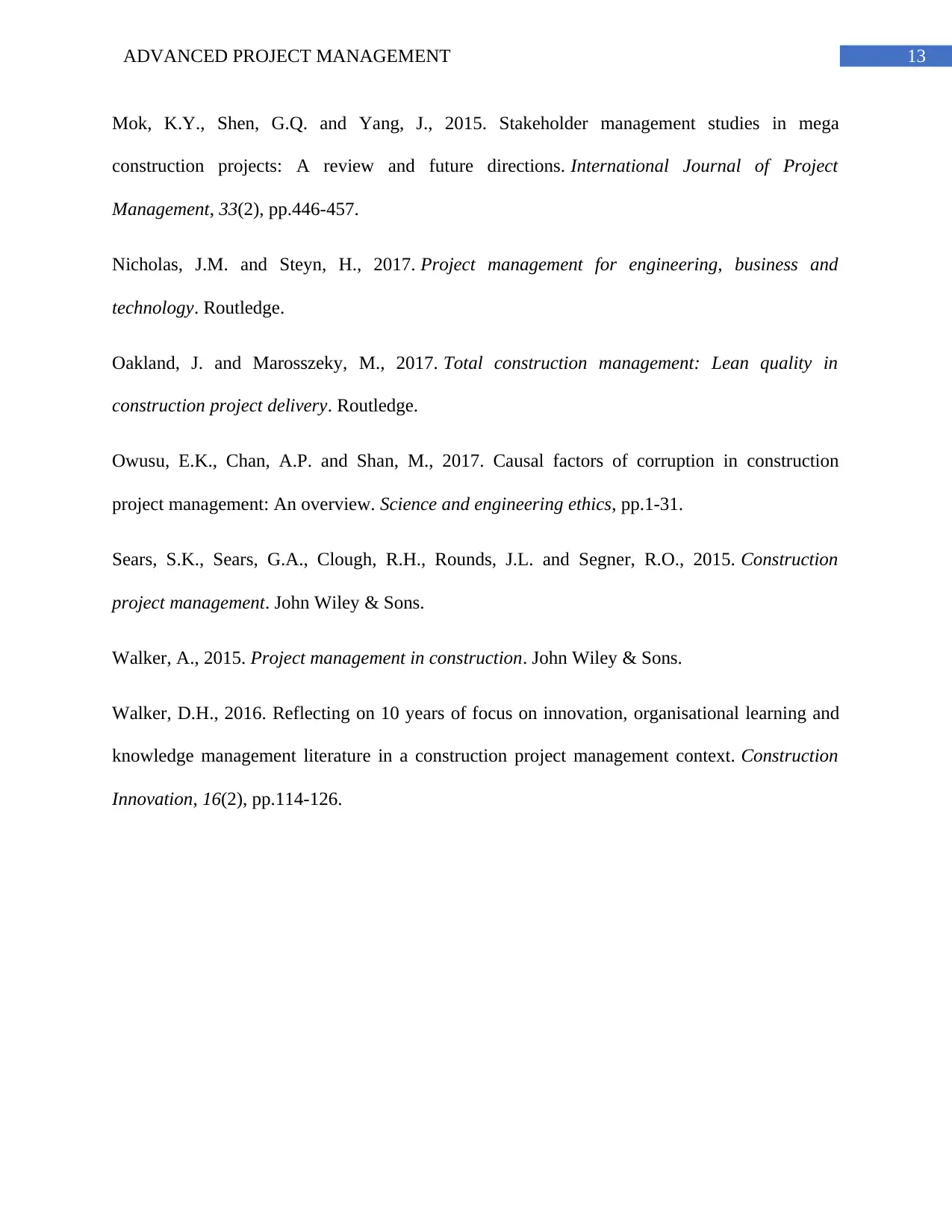
13ADVANCED PROJECT MANAGEMENT
Mok, K.Y., Shen, G.Q. and Yang, J., 2015. Stakeholder management studies in mega
construction projects: A review and future directions. International Journal of Project
Management, 33(2), pp.446-457.
Nicholas, J.M. and Steyn, H., 2017. Project management for engineering, business and
technology. Routledge.
Oakland, J. and Marosszeky, M., 2017. Total construction management: Lean quality in
construction project delivery. Routledge.
Owusu, E.K., Chan, A.P. and Shan, M., 2017. Causal factors of corruption in construction
project management: An overview. Science and engineering ethics, pp.1-31.
Sears, S.K., Sears, G.A., Clough, R.H., Rounds, J.L. and Segner, R.O., 2015. Construction
project management. John Wiley & Sons.
Walker, A., 2015. Project management in construction. John Wiley & Sons.
Walker, D.H., 2016. Reflecting on 10 years of focus on innovation, organisational learning and
knowledge management literature in a construction project management context. Construction
Innovation, 16(2), pp.114-126.
Mok, K.Y., Shen, G.Q. and Yang, J., 2015. Stakeholder management studies in mega
construction projects: A review and future directions. International Journal of Project
Management, 33(2), pp.446-457.
Nicholas, J.M. and Steyn, H., 2017. Project management for engineering, business and
technology. Routledge.
Oakland, J. and Marosszeky, M., 2017. Total construction management: Lean quality in
construction project delivery. Routledge.
Owusu, E.K., Chan, A.P. and Shan, M., 2017. Causal factors of corruption in construction
project management: An overview. Science and engineering ethics, pp.1-31.
Sears, S.K., Sears, G.A., Clough, R.H., Rounds, J.L. and Segner, R.O., 2015. Construction
project management. John Wiley & Sons.
Walker, A., 2015. Project management in construction. John Wiley & Sons.
Walker, D.H., 2016. Reflecting on 10 years of focus on innovation, organisational learning and
knowledge management literature in a construction project management context. Construction
Innovation, 16(2), pp.114-126.
1 out of 14
Related Documents
Your All-in-One AI-Powered Toolkit for Academic Success.
+13062052269
info@desklib.com
Available 24*7 on WhatsApp / Email
![[object Object]](/_next/static/media/star-bottom.7253800d.svg)
Unlock your academic potential
© 2024 | Zucol Services PVT LTD | All rights reserved.




